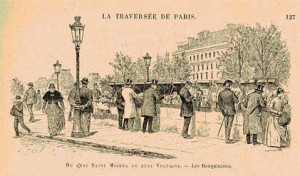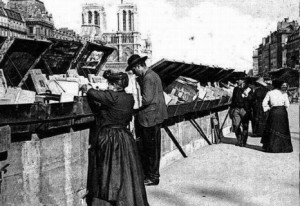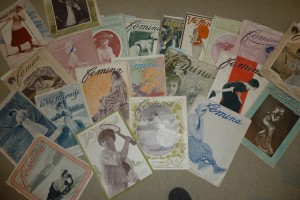By Rachel Mesch
It’s a scene any tourist will recognize: along the picturesque quais of the Seine, vendors with their green, rectangular boxes line the sidewalks, peddling colorful postcards and souvenirs, knick knacks and paintings, a little piece of Paris to bring home.
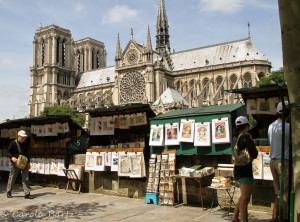 For the scholar, on the other hand, these traditional booksellers, with their used books and old magazines, offer a key to the past. The bouquinistes (pronounced boo-kee-neest), as they are known, bring our archives out of the dark quiet of rare book rooms and display them in the midst of the bustling Parisian cityscape. Without call numbers or catalogs, we weave through the thick rope of tourists and scan from stand to stand, looking for the telltale fraying leather covers of timeworn texts, or the mastheads of old newspapers and magazines.
For the scholar, on the other hand, these traditional booksellers, with their used books and old magazines, offer a key to the past. The bouquinistes (pronounced boo-kee-neest), as they are known, bring our archives out of the dark quiet of rare book rooms and display them in the midst of the bustling Parisian cityscape. Without call numbers or catalogs, we weave through the thick rope of tourists and scan from stand to stand, looking for the telltale fraying leather covers of timeworn texts, or the mastheads of old newspapers and magazines.
For the dix-neuviémiste, the scholar of nineteenth-century French literature, it is rare that a librarian at the Bibiliothèque Nationale de France will hand us an actual book t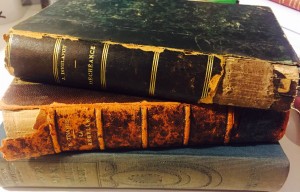 hese days.
hese days.
Nineteenth-century printers moved from using cotton and linen to wood pulp for their paper, and due to the high acidity of this new material, the pages of these books now crumble easily at the slightest touch. As a result, the national library has scanned these texts, and we are forced to read them through a screen. What a thrill, then, to find a long out of print nineteenth-century novel hidden on the shelf of the bouquiniste! For five, ten, fifteen Euros, one can carefully study an obscure text on the terrace of a neighboring café instead of the solitude of the microfilm chamber.
If the bouquinistes seem as old as Paris itself, it’s because they nearly are. Dating back to the sixteenth century, these vendors increased steadily over the periods that followed. During the French Revolution, they further multiplied, circulating high demand political brochures and newspapers; their numbers swelled again during the Paris Worlds Fairs, or Expositions Universelles, at the end of the nineteenth century, as millions thronged the city to see its new iron skyscraper. Now mini Eiffel towers populate the shelves of certain vendors alongside the used books, or bouquins, that they are named for, in standard sized wooden vestibules regulated by the government.
As a scholar trained in literary studies, encountering copies of books central to my research has been exhilarating, as it brings the notion of material culture to life. Holding an original copy of a book you are trying to situate historically and contextually puts you, quite literally, in touch with this very history and context. If you are lucky, the previous owner has left some trace of his or her presence–a signature, an oily fingerprint–a sign of the book having been owned, read, handled.
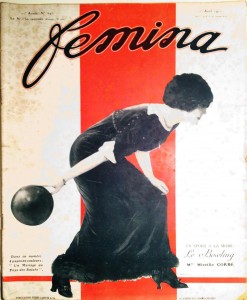 And then, if you are even luckier, you might fall in love. It was on the quais of the Seine that I first purchased a copy of Femina, the first photographic women’s magazine published in France. Launched in 1900 by entrepreneurial journalist Pierre Lafitte, who had an important intuition about female market share, the magazine was a cross between Vogue and Ladies Home Journal, consciously aimed at the Belle Epoque female reader who wanted to take on modern roles without abandoning her femininity.
And then, if you are even luckier, you might fall in love. It was on the quais of the Seine that I first purchased a copy of Femina, the first photographic women’s magazine published in France. Launched in 1900 by entrepreneurial journalist Pierre Lafitte, who had an important intuition about female market share, the magazine was a cross between Vogue and Ladies Home Journal, consciously aimed at the Belle Epoque female reader who wanted to take on modern roles without abandoning her femininity.
Eventually, in preparation for the book that I would write on the topic, I devoured the whole print run of Femina in bound library volumes and, yes, microfilm readers. But the project was launched by that first physical contact with someone’s old copy discovered in the shadows of a green wooden box. Excitement stirred in me as I thumbed through its outsize pages, with advertisements for hair products and furniture alongside gorgeous portraits of women writers (some of whose novels I had purchased previously from other bouquinistes…) and other women achieving in fabulous and daring new ways; more than a window onto a past era, the magazine offered direct contact, as I caught a weight loss advertisement slip from its pages, a card announcing an upcoming lecture, the occasional copy of a lithograph by a popular artist. Being able to buy my own copies of Femina not far from the kiosks where Parisian women would flock to purchase them in the 1900s set the project in motion from a place of passion and connection.
That place is Paris, where even research can be romantic. #LifeLoveParis
___
For a brief history of the bouquinistes, see “Histoire des bouquinistes des quais de la Seine” on Paris ZigZag. For a bit more detail, see the Bouquinistes de Paris’s own website.
To see how little has changed in the past century, check out these amazing images starting from 1900.

